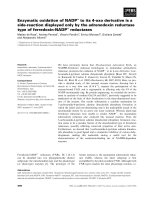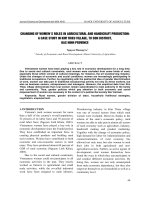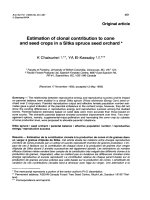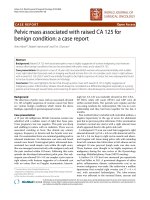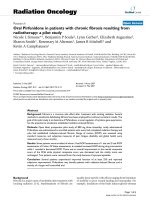Báo cáo khoa hoc:" Severe generalised hypersensitivity reaction to topical neomycin after cataract surgery: a case report" ppsx
Bạn đang xem bản rút gọn của tài liệu. Xem và tải ngay bản đầy đủ của tài liệu tại đây (351.18 KB, 3 trang )
BioMed Central
Page 1 of 3
(page number not for citation purposes)
Journal of Medical Case Reports
Open Access
Case report
Severe generalised hypersensitivity reaction to topical neomycin
after cataract surgery: a case report
Imran A Ansari* and Ernest Onyema
Address: Department of Ophthalmology, Princess Alexandra Hospital, Harlow, Essex, UK
Email: Imran A Ansari* - ; Ernest Onyema -
* Corresponding author
Abstract
Introduction: Systemic hypersensitivity reactions to topical ophthalmic treatment occur rarely,
but when they do they can be severe as highlighted by this case.
Case presentation: A post-operative cataract surgery patient developed a severe and
generalised hypersensitivity reaction following topical treatment with Maxitrol (Dexamethasone
and Neomycin) eye drops. The patient reported a previous allergic reaction to Neomycin.
Conclusion: This case report emphasises the importance of a thorough drug and allergy history
when patients are seen at pre-assessment or clerked in for surgery.
Introduction
Adverse external ocular effects of topical ophthalmic ther-
apy have been estimated to occur in 10 % of all adverse
reactions [1].
Drug-related ocular allergies are often the result of type IV
hypersensitivity reactions, although type 1 and type 3
hypersensitivity reactions may also be involved [2].
Hypersensitivity to localised ocular therapy may involve a
localised contact reaction which may include itching, red-
ness, tearing, mucopurulent discharge, and papillary con-
junctivitis as well as corneal involvement [3]. Dermatitis,
oedema and chemosis of the eyelids and skin can also
occur [4].
Anaphylactoid reactions are rare and can be the result of
type 1 (immediate) hypersensitivity reactions [1]. They
are not usually associated with systemic anaphylaxis but
involve an acute shock syndrome that may be immuno-
logically mediated [5].
Anaphylactoid reactions are characterised by acute itch-
ing, conjunctival hyperemia, chemosis and oedema of
skin in the form of urticaria and angioedema Neomycin is
an antibiotic that is often used in the form of Maxitrol
(Neomycin, Polymyxin B and Dexamethasone) after cata-
ract surgery in the prophylaxis of infection.
When used in ophthalmic preparations, it is well known
to be a cause of allergic localised contact reactions, but it
is rare for it to cause a diffuse cutaneous systemic reaction
[6]. One study has estimated the incidence of allergic con-
tact reactions to topical neomycin as 1 to 29/100,000 [7].
We describe a case of severe systemic allergy with a diffuse
cutaneous hypersensitivity reaction following topical
ophthalmic administration of neomycin in the form of
Maxitrol.
Case presentation
An 80 year old Caucasian male underwent routine
phacoemulsification cataract extraction with posterior
chamber intraocular lens implant.
Published: 23 February 2008
Journal of Medical Case Reports 2008, 2:57 doi:10.1186/1752-1947-2-57
Received: 9 July 2007
Accepted: 23 February 2008
This article is available from: />© 2008 Ansari and Onyema; licensee BioMed Central Ltd.
This is an Open Access article distributed under the terms of the Creative Commons Attribution License ( />),
which permits unrestricted use, distribution, and reproduction in any medium, provided the original work is properly cited.
Journal of Medical Case Reports 2008, 2:57 />Page 2 of 3
(page number not for citation purposes)
The patient had a history of hypertension and hypercho-
lesterolemia for which he was using Atenolol and Simvas-
tatin. He also had a history of bladder cancer for which he
had received chemotherapy and radiotherapy.
Of note, the patient had reported an allergic reaction to
Neomycin ear drops 30 years previously. This had left him
with a rash that improved a few days later.
The patient was discharged after a straight forward cataract
operation on Maxitrol eye drops four times a day.
He was seen the next day for the first post-operative visit,
and up until then had used Maxitrol twice to the affected
eye.
At that stage the patient's eye was noted to be slightly
more injected than usual but no further concerns were
raised. Papillae were noted on the palpebral conjunctiva
and treatment was continued.
The patient was then reviewed 2 weeks post-operatively
and had continued to use Maxitrol up until that time. He
was found to have increased facial erythema, swelling and
crusting around the lids. (see Fig. 1). He also complained
of a severe and generalised rash affecting his legs, arms,
back and buttocks which was painful. (Figs. 2 and 3). No
other mucus membranes were involved.
Generalised hypersensitivity reaction involving the trunk and lower limbsFigure 2
Generalised hypersensitivity reaction involving the
trunk and lower limbs.
Severe pruritic periorbital rash and swelling around left eyeFigure 1
Severe pruritic periorbital rash and swelling around
left eye.
Maculo-papular rash – Involvement of the lower limbFigure 3
Maculo-papular rash – Involvement of the lower
limb.
Publish with BioMed Central and every
scientist can read your work free of charge
"BioMed Central will be the most significant development for
disseminating the results of biomedical research in our lifetime."
Sir Paul Nurse, Cancer Research UK
Your research papers will be:
available free of charge to the entire biomedical community
peer reviewed and published immediately upon acceptance
cited in PubMed and archived on PubMed Central
yours — you keep the copyright
Submit your manuscript here:
/>BioMedcentral
Journal of Medical Case Reports 2008, 2:57 />Page 3 of 3
(page number not for citation purposes)
Treatment with systemic Prednisone 20 mg once a day
and Betnovate eye ointment relieved his symptoms
remarkably, and 3 weeks later all signs of inflammation
were gone.
Conclusion
Systemic hypersensitivity reactions to topical ophthalmic
treatment occur rarely. but when they do they can be
severe as highlighted by this case.
Although the patient in this report had a substantial
improvement in best-corrected visual acuity from count-
ing fingers pre-operatively to 6/9 post-operatively, he
endured a long and painful recovery which otherwise
would have been quick and straight forward. An alterna-
tive post-operative regime could have been Pred Forte and
Chloramphenicol eye drops four times a day.
This case report emphasises the importance of a thorough
drug and allergy history when patients are seen at pre-
assessment or clerked in for surgery. Even when drugs are
given topically and locally, the possibility of a severe sys-
temic reaction should always be borne in mind even
though these are rare. As physicians it is also important for
us to educate our patients about the signs and symptoms
of such an allergic reaction so the patient will return to us
sooner for treatment.
Competing interests
The author(s) declare that they have no competing inter-
ests.
Authors' contributions
IAA was the main author and is the corresponding author.
EO is the co-author. All authors read and approved the
final manuscript.
Consent
Written informed consent was obtained from the patient
for publication of this Case report and accompanying
images. A copy of the written consent is available for
review by the Editor-in-Chief of this journal.
Acknowledgements
No funding was necessary for this article.
References
1. Wilson FM II: Adverse external ocular effects of topical oph-
thalmic therapy: an epidemiologic, laboratory, and clinical
study. Trans Am Ophthalmol Soc 1983, 81:854-965.
2. Wilson , Fred M II: Allergy to Topical Medications. Interna-
tional Ophthalmology Clinics. Recent Trends in Ocular Allergy
2003, 43(1):73-81. Winter
3. Wilson FM II: Adverse external ocular effects of topical oph-
thalmic medications. Surv Ophthalmol 1979, 24:57-88.
4. Stern GA, Knapp A: Iatrogenic peripheral corneal disease. Int
Ophthalmol Clin 1986, 26:77-89.
5. Wise DJ, Carter GR: Immunology. A comprehensive review.
Ames, Iowa: Iowa State University Press; 2002.
6. Baldinger J, Weiter JJ: Diffuse cutaneous hypersensitivity reac-
tion after dexamethasone/polymyxin B/neomycin combina-
tion eye drops. Source Annals of Ophthalmology 1986, 18(3):95-6.
7. de Pádua CA, Uter W, Schnuch A: Contact allergy to topical
drugs: prevalence in a clinical setting and estimation of fre-
quency at the population level. Pharmacoepidemiol Drug Saf 2007,
16(4):377-84.
